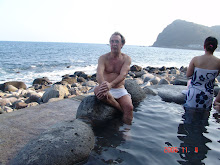



To share the japanese tradition of Hadaka no Tsukiai"







 in Japan taking a bath was generally more for purification of the soul that only for cleaning the body.
in Japan taking a bath was generally more for purification of the soul that only for cleaning the body. The Empress Komyo : Old writings have shown that in the budhist temples during the 8th century there were steam bath. Wealthy people were paying all costs hopping to be payed back by god. Those wealthy people were taking care of the bath of the poor and the sick person themselves.
The Empress Komyo : Old writings have shown that in the budhist temples during the 8th century there were steam bath. Wealthy people were paying all costs hopping to be payed back by god. Those wealthy people were taking care of the bath of the poor and the sick person themselves.
 I will show a few onsen i went and where the people who goes there respects still the way i suppose japanese people were soaking in the past before western influence;
I will show a few onsen i went and where the people who goes there respects still the way i suppose japanese people were soaking in the past before western influence; The bath is one of the few practices which has not been imported from China, the origine comes from a purification ritual related to Shinto belief. Before entering in a temple believer have to purify themself with water. Taking a bath would therefore be associated with an other Shinto purification ritual; the salt heap in front of many houses or stores.
The bath is one of the few practices which has not been imported from China, the origine comes from a purification ritual related to Shinto belief. Before entering in a temple believer have to purify themself with water. Taking a bath would therefore be associated with an other Shinto purification ritual; the salt heap in front of many houses or stores. Hoshi Onsen : A tast of the japanese bathing tradition
Hoshi Onsen : A tast of the japanese bathing tradition
Hoshi Onsen is unique among all onsen in Japan. Originally built in the 1870's the onsenis mananged by the fifth generation of the Okamura family.
Hoshi Onsen is said to be one of the only 50 onsen sites built directly at the source, water flows directly up through a peble and rock aquafiltre. No water is added to cool down.
There are two inside bath the large one mixed and the other for ladies, open for day bath from 10:30 to 13:30 . Many couples meet at this place but some time too many men are soaking in front of the lady changing room door . In the water no towel are autorizide.
Soaking in the water inside the old building the view of the wooden structure is extraordinary. In this place you get a litlle tast of the japanese tradition of mixed bathing in the Edo periode. Enjoy and respect the rules
Adress: From Tokyo take the Shinkansen Joetsu to Jomokogen, the the public bus to Sarukyo and transfert to the Hoshi shutlle (calla before)
 Sukayu Onsen : A new challenge for the tradition of mixed bathing :
Sukayu Onsen : A new challenge for the tradition of mixed bathing :